

Native Grown + Gathered: Strengthening Indigenous Food Sovereignty
The Native Grown and Gathered Assessment Report provides an in-depth analysis of the challenges and opportunities facing Native-owned food and agricultural businesses. This report draws on interviews and surveys conducted with 44 Native food producers, identifying key areas for growth, funding needs, and technical support required to strengthen Native food sovereignty.

Climate-Smart Agriculture: Indigenous Environmental Network Climate Justice Program Series
As the impacts of weather changes worsen, Indigenous peoples and small farming communities are being targeted by the lure of Climate-Smart Agriculture (CSA). CSA casts a wide net, including land-use practices, limiting crop selection, and agricultural products that are presented as solutions to the food crisis and environmental changes.

Building a Native Agritourism Ecosystem - AIANTA Webinar Series
Learn from the owner of DX Beef and The DX Ranch, Kelsey Ducheneaux (Cheyenne River Sioux), and how their passion to help their consumers reconnect with their food source has driven them to build DX Beef into a Native Agritourism Ecosystem and how their willingness to share their skills and culture with guests resulted in The DX Ranch.

Gaining Ground: A Report on the 2018 Farm Bill Successes for Indian Country and Opportunities
This report summarizes specific opportunities for Indian Country in each Farm Bill title. Potential changes identified would enhance Tribal Nations’ and Native producers’ access to important USDA programs and authorities that build communities, create jobs, grow economies, feed people, safeguard natural resources, and prioritize Tribal sovereignty.

Intertribal Food Systems National Survey and Report
This report by Indigenous Food and Agriculture Initiative identifies and shares community-based, food system innovations in tribal communities and throughout Indian Country. By sharing the results, the initiative hopes to inform potential funders, food system practitioners and researchers of change-makers in this space

Source of Inspiration for Tribal Farmers, Ranchers and Producers - Case Studies in Tribal Agritourism
A groundbreaking new handbook by American Indian and Alaskan Native Tourism Association (AIANTA), is developed for Native food producers interested in sharing culture, heritage and traditional food systems by expanding or developing agritourism enterprises.

American Indian/Alaska Native Agriculture Producers - USDA Census
The Census of Agriculture, taken only once every five years, looks at land use and ownership, operator characteristics, production practices, income and expenditures. The American Indian/Alaska Native Producers highlight shows statistics about agricultural products, producers, farms, and sales.

Native Ag Media Education Webinar Series
A two-part webinar series focused on educating media professionals on the history and best practices for covering Native Agriculture in the media. Presentations included “Indian Country 101” and “Telling the story of Tribal agriculture.”

Reimagining Native Food Systems: A Vision for Native Food and Agriculture Infrastructure Rebuilding and Recovery
This landmark report by NAAF outlines a plan to build processing, packaging, and distribution infrastructure to support Indian country’s farmers, ranchers, fishers, and harvesters while simultaneously feeding Tribal communities and meeting their nutritional needs.

Building Native Agriculture - Webinar Series
The NAAF webinar series “Sowing the Seeds of Growth through Capacity Building” focuses on how foodways, cultures, and needs tie into the different building blocks for Indigenous agriculture systems. This series supports organizations as they work to build their own robust economies in agriculture.

Reimagining Hunger Responses in Times of Crisis
This report highlight the disproportionate impact of COVID-19 on food insecurity among Native American communities. It emphasizes the need for improved data collection, better infrastructure, and enhanced federal nutrition programs to strengthen food security and sovereignty for Native communities.

Building Native Agriculture: Sowing the Seeds of Growth with Capacity Building - NAAF
This report by the NAAF provides a comprehensive guide for Tribes and Tribal organizations to develop agricultural economies and food sovereignty through strategic planning, feasibility assessments, and infrastructure development.
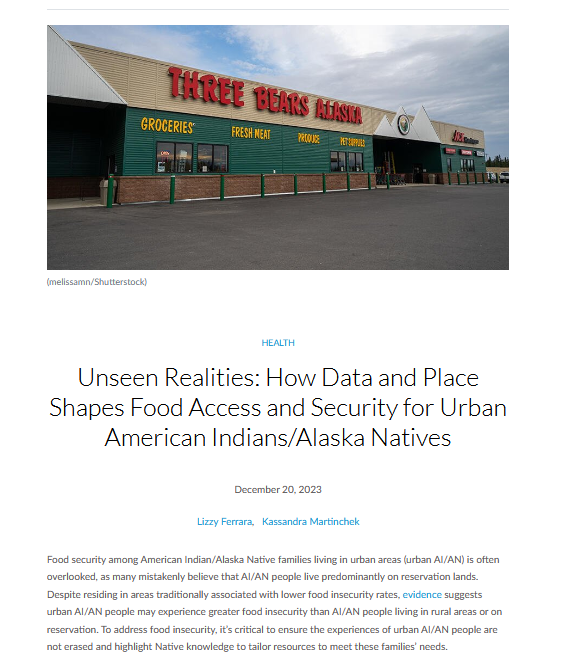
Unseen Realities: How Data and Place Shapes Food Access and Security for Urban American Indians/Alaska Natives
Food security among American Indian/Alaska Native families living in urban areas is often overlooked, as many mistakenly believe that AI/AN people live predominantly on reservation lands. This article discusses missing local-level data on food access and addressing data violence to strengthen policies to lessen food insecurity and health disparities.
This CoP session focused on the development of infrastructure as a precursor to a wide range of economic development activities. It featured three SME panelists representing a federal agency, a tribe in the process of expanding their water infrastructure, and an organization that supports the development of self-determined efforts of tribes to transition towards clean energy systems.
This session provides a non-exhaustive list of funding sources and the eligible uses and combinations of these sources as well as training on how to advance economic development through external borrowing/financing of activities (as opposed to purely grant-funded approaches) during the development and implementation of financing plans.
This session featured a panel of experts who work for tribal and Native organizations that operate food sovereignty programs or are actively developing Native food systems in collaboration with Native producers, restaurateurs, schools, and providers of food assistance programs and/or who provide grants, loans, financing and technical assistance in support of these activities.
Many tribal and Native economic development plans are never fully implemented. This section will focus on the critical shift from planning to plan implementation. It will cover the timing and sequencing of coordinated and diversified economic development activities . It will also cover how to turn loose planning partnerships into solid development partnerships.
Broadband and telecommunications, are sectors that represent areas of significant infrastructural need with tribal and Native lands, provide tremendous current opportunities for significant funding, and offer fertile ground for new partnerships with non-Native entities and governments.
This in-person training at the 2024 NAIHC Legal Symposium in Las Vegas underscores the foundational elements of economic development and provided strategies for developing each of these specific elements. This training covered:
Workforce Development and Housing as Economic Development
Building Entrepreneurial Ecosystems
This virtual training introduced participants who are entering or considering an economic development planning process to its core components. Participants learned about the key internal and external actors, the process’s timeline and duration, the data required, and critical outcomes.
This session discussed strategic planning for indigenous tourism development, an intro to ATNI-EDC and Harvard Project on Indigenous Governance and Development, and highlighted tourism projects across Indian Country such as:
The Wind River Development Fund
NC Growth - Native Edge Tourism Technical Assistance Center
Akwesasne Travel of the St. Regis Mohawk Tribe
This first section of the track underscores the foundational elements of economic development plan implementation, including a qualified workforce/labor pool, an entrepreneurial ecosystem, and the primary infrastructure necessary to support economic activities.
This session featured the presentation of two unique funding mechanisms for supporting community economic development in tribal and Native communities, including Section 105(l) leases and Treasury’s State Small Business Credit Initiative (SSCBI), as well as an introduction to some useful tools and Resources the EDA offers for underserved communities
The first training in the CoP’s 9-part series of a variety of topics across Indian Country. Cris Gastner and Kevin Klingbeil from Big Water Consulting led a discussion and exercises about the foundations and essential components of CED in Indian Country and an introduction to CED planning.
The discussion centered around how project leaders identified a need for the facilities in their communities, how they secured funding, and the impacts the health centers will have and are having on community economic development. Experts also discussed how the 105(l)-lease program can help fund and support Native health centers.
The August CoP session featured a panel of grant experts who discussed strategies for writing successful grants and attracting other capital, common mistakes and other barriers to the grant writing process, and opportunities to reduce or eliminate barriers.
This session featured a panel of data experts who shared their experience working with and collecting new tribal and Native economic data.
As tribes work on projects to grow and improve their communities, it is essential that all the various sectors of community economic development are involved in the conversation together through a holistic planning process.
The session featured a panel discussion on the impacts of energy projects on tribal and Native lands. Our panelists Kenneth Ahmann, Ken Stock, and Wendolyn Holland shared a wealth of expertise and insight into the importance and timeliness of the energy sector and its impact on community economic development.
During this monthly session SMEs discussed the barriers to and the benefits of tribal citizen entrepreneurship. A lack of financial literacy, limited access to capital, and inconsistent rules & regulations have made it difficult for tribal citizens to start business ventures.
Over 90 people attended the session from across the country, including from Alaska and Hawaii. Participants came from tribal enterprises, tribal planning departments, Native CDFIs, state and federal agencies, academia, regional tribal associations, and more. Attendees reported a range of experience with EDA grants.
Related: Infrastructure & Utilities Resources
The DOT’s Build America Bureau offers $27 million in technical assistance grants to rural and tribal communities for the planning and design phase development of transportation projects. There is no local funding match required to participate in this program. The Bureau designated up to $10 million for Tribal applicants.
This toolkit is intended for a variety of rural entities, including local communities, Tribal governments, and individuals. The majority of information in this toolkit is most relevant to rural entities seeking to install charging stations for broader public or private use.
The Tribal section of the Transit Manager’s Toolkit includes information and guidance to ensure that Tribal transit managers are aware of available resources to successfully provide rides for Tribal citizens.
The DOT’s Build America Bureau offers $27 million in technical assistance grants to rural and tribal communities for the planning and design phase development of transportation projects. There is no local funding match required to participate in this program. The Bureau designated up to $10 million for Tribal applicants.
This program from USDA Rural Development helps get safe reliable drinking water and waste disposal services to low-income communities that face significant health risks. Funds can be used to build basic drinking water and waste disposal systems, including systems to handle stormwater drainage.
The EPA sets aside up to 2% of the Drinking Water State Revolving Fund (DWSRF) for grants to improve the infrastructure of drinking water systems that serve Tribes.
The DOT sets aside funds to address transportation safety issues identified by federally recognized tribes through a competitive, discretionary program. Projects are chosen whose outcomes will reduce fatal and serious injuries in transportation related incidents, such as motor vehicle crashes.
A 105(l) lease is an agreement between Indian Affairs and a Tribe or Tribal Organization to reimburse facility costs incurred while carrying out programs, services, functions, and activities (PSFAs).
EECBG Program provides $8.8 million to 774 eligible Tribes, including Alaska Native Regional and Village and can be used to upgrade buildings, install renewable energy equipment, or develop climate and clean energy plans.
The NSFLTP provides funding for the construction, reconstruction, and rehabilitation of nationally significant projects with a minimum expected cost of $12 million within, adjacent to, or accessing Federal and Tribal lands.
The BIA’s Climate Resilience program will support federally recognized Tribes and Tribal orgs as they address current and future climate change impacts on Tribal Treaty and Trust resources, economies, regenerative agriculture, food sovereignty, conservation practices, infrastructure, and human health and safety. All 2024 award applications must be submitted online by October 18, 2024.
This toolkit shares the findings of NCAI’s “Building Tribal Economies” research and outreach initiative, which works to train the focus of Tribal Nations on the strategic, foundational considerations involved with building integrated and resilient tribal economies capable of supporting their communities and citizens today, tomorrow, and for generations to come.
The USDA Community Facilities Direct Loan & Grant program provides grants and affordable funding to develop essential community facilities in rural areas including Tribal communities.
The Indian Community Development Block Grant (ICDBG) Program provides direct grants for development such as decent housing, suitable living environments, and economic opportunities in American Indian and Alaska Native Communities. Projects funded by the ICDBG program must principally benefit low-and-moderate income persons.
The Economic Adjustment Assistance (EAA) (PDF) program is EDA’s most flexible program; it provides a wide range of technical, planning, and public works and infrastructure assistance in regions experiencing adverse economic changes that may occur suddenly or over time.








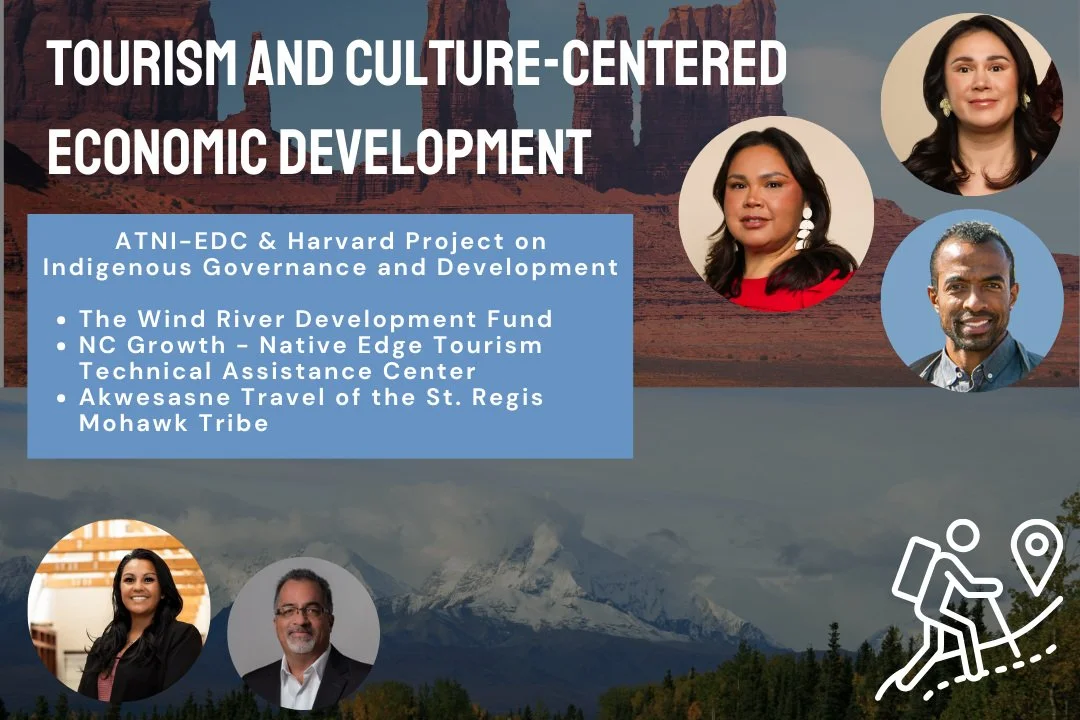
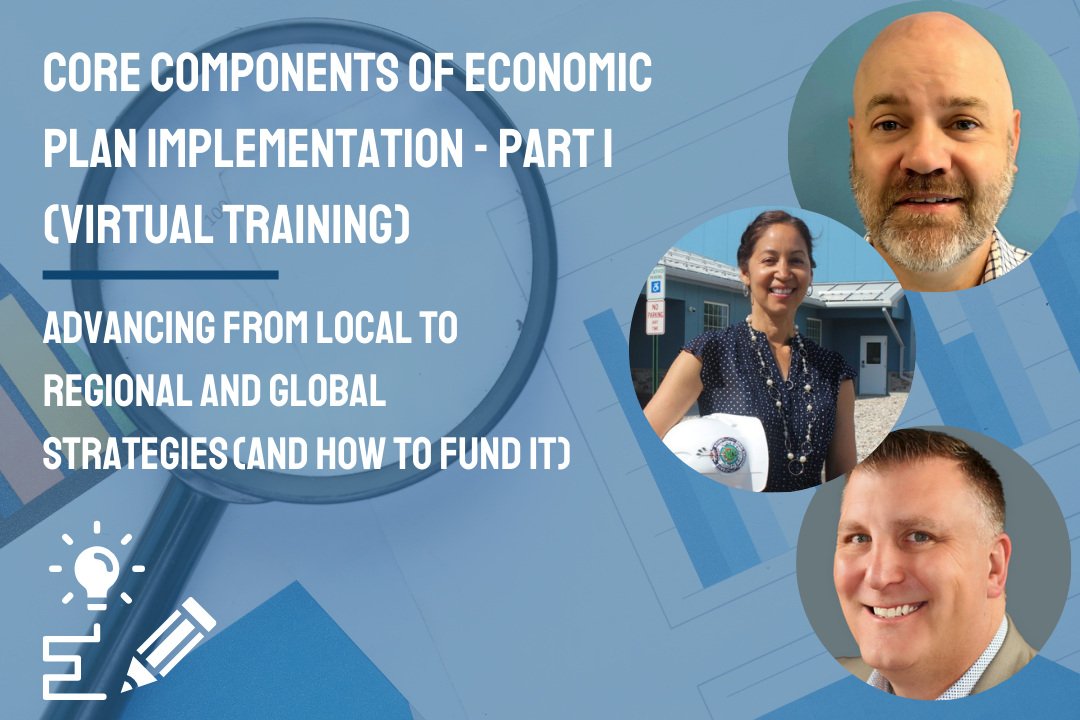














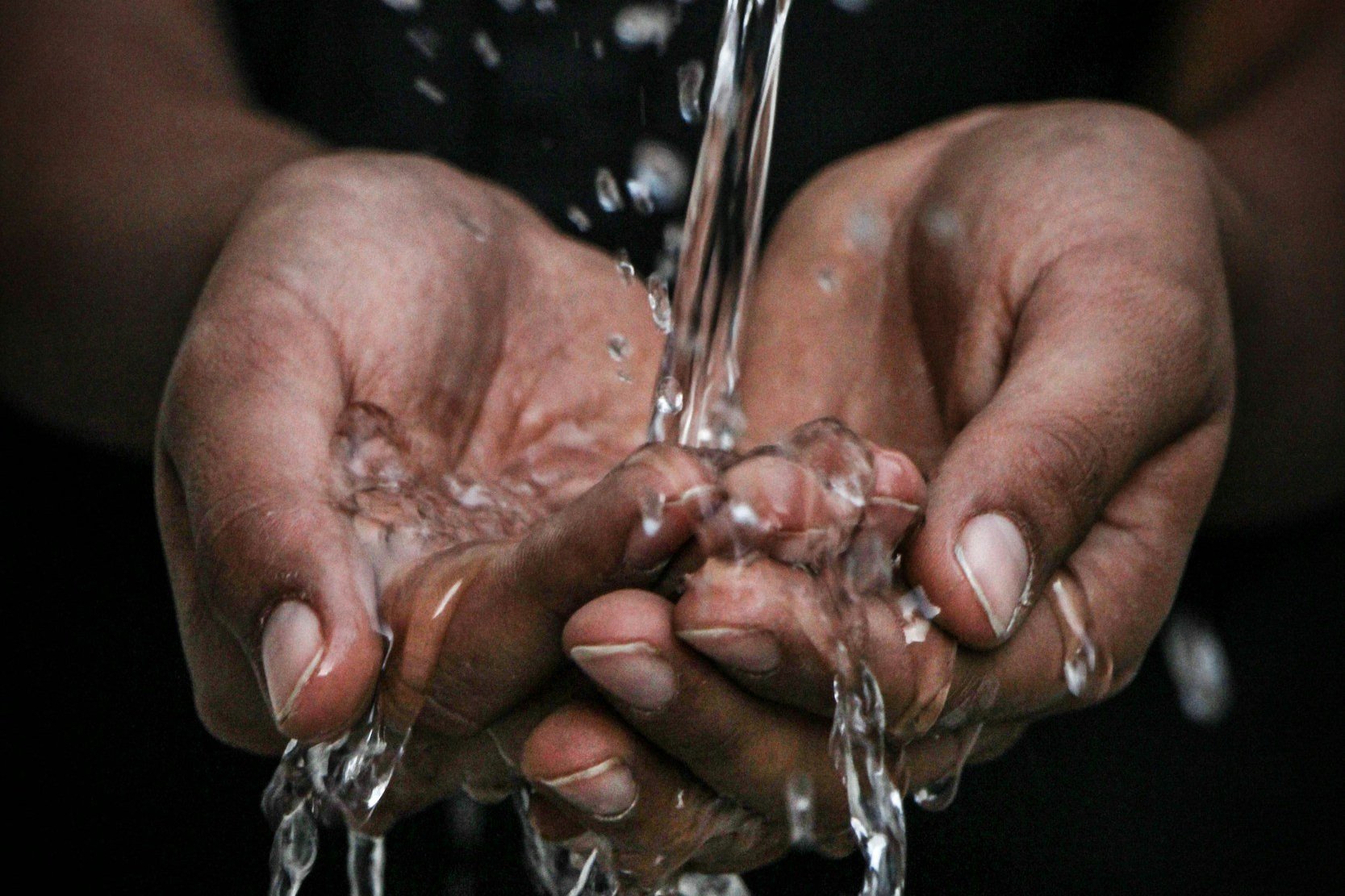








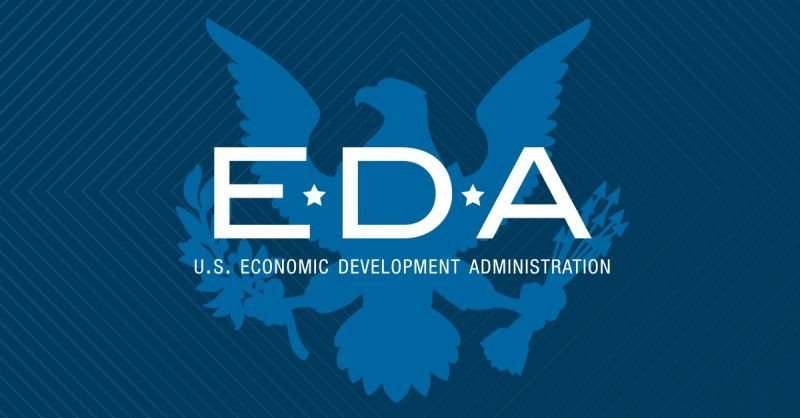
The session featured a discussion of topic-driven member-led committees and a presentation from Dustin Goslin of Mille Lacs Corporate Ventures.